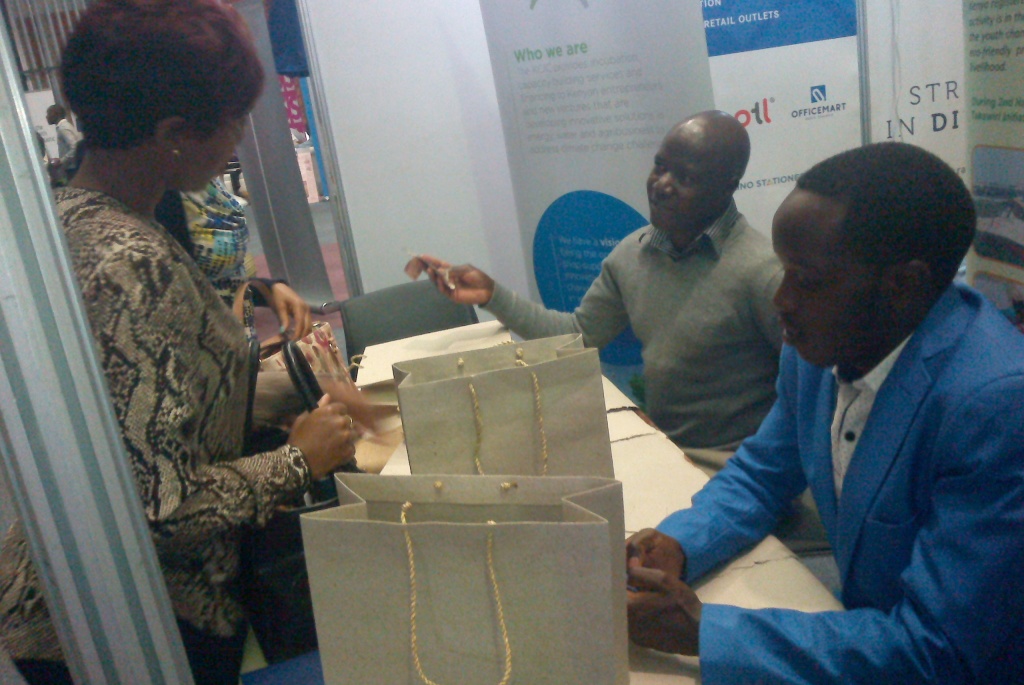
Michael Otieno (Center) explaining a point to a customer at the National Science Technology Innovation Week at KICC, Nairobi on 24th August 2017.
A Kisumu based entrepreneur is taking advantage of Kenya’s ban on plastic bags to produce Eco-friendly paper bags from water hyacinth menace in Lake Victoria.
Michael Otieno, the founder of Takawiri Craft Enterprises turned the problem into a business opportunity. He has been using the weed and re-cycled waste paper to make business cards, book covers, and envelopes since 2011. In 2016 he started making gift bags which he sells together with the rest of the items to maintain sustainable livelihood.
“My enterprise is part of the environmental solution in fighting the effects of the weed in Kenyan lakes” says Michael.The weed has affected the socio-economic livelihoods of many fishermen in Lake Victoria as it depletes oxygen leading to dwindling fish population. Michael thinks this can be solved by mechanizing the removal of the weed so as to assist fishermen fish easily and increase the fish in the lake.
He was the winner of the 3rd prize in the Small and Medium Enterprises Category (SMEs) in 2016 and was a participant in this year’s National Science Technology and Innovation Week which was held at the Kenyatta International Convention Center from 24th August to 25th August 2017.
Michael who completed high school in 2010 started his enterprise after attending training offered by a Non-Governmental Organization in Kisumu. With an initial capital of 10,000 shillings, he purchased a pulping machine.

A sample of a gift bag made from water hyacinth by Takawiri Craft Enterprises
He currently employs 5 to 10 casuals who collect the weed from the shores of Lake Victoria manually by hand. The weed is then transported to his business premises where it’s chopped using knives and then dried on the sun with the aid of his 5 permanent employees. It takes approximately 8 to 12 hours for the weed to dry but depending on the weather patterns it may take 2 days to be completely dry.
After it has dried, the weed is crushed using a pulping machine and mixed with water then suspended on a wire frame where particles are sieved and the remainder is used to make pulp.
Once the paper is dry, it is passed through a calendaring machine which presses the paper to obtain a smooth finish.
READ ALSO: Water hyacinth provides good substrate for mushroom farming
READ ALSO: Water hyacinth turned to animal feed
One of the major challenges Michael has encountered is inadequate capital to mechanize the production of the paper. “The whole process from weed collection to production of paper is manual in which I produce at least 100 sheets of paper per day” noted Michael.
With increased demand for his products, he is seeking support from the government so as to enable him purchase machines to make the production of paper faster and easy.
Some of his clienteles include the Kenya Climate Innovation Center (KCIC), gift shops and book publishers who make orders of up to 2,000 items per month. Michael sells an A4 gift bag for 150 shillings and an A5 for 75 shillings. However, the items are tailor made to suit customers’ demands.
He can be reached on 0720668591/0720449758 or by email This email address is being protected from spambots. You need JavaScript enabled to view it.
Write comment (0 Comments)

















